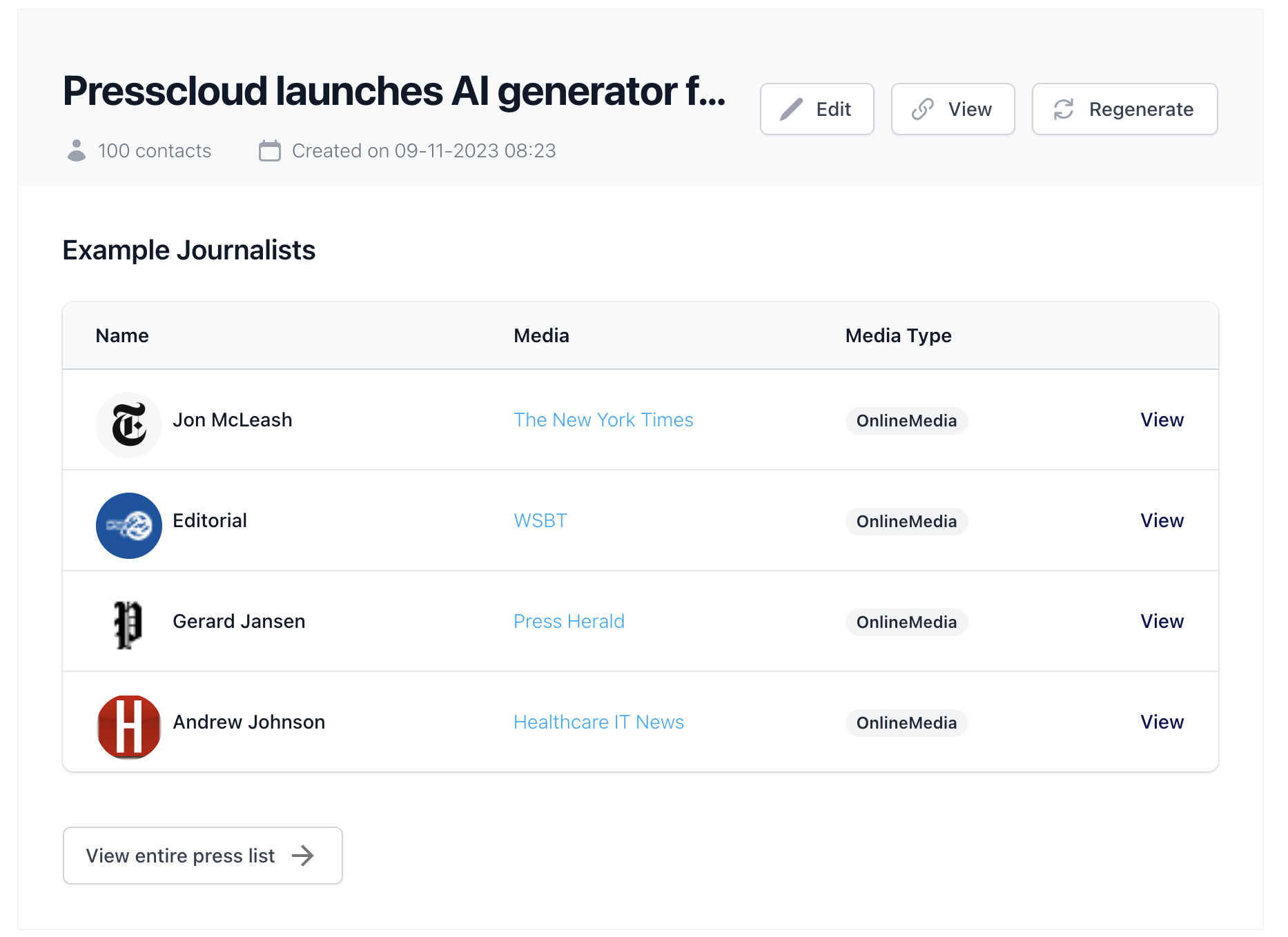The Ideal Length of a Press Release: How Many Words to Hit the Mark
The length of a press release plays a crucial role in effectively conveying your message to the media and target audience. Knowing how many words to include can make the difference between capturing attention or being overlooked. In this article, we will explore the importance of press release length, how it affects media communication, and tips for writing concise and impactful press releases. Additionally, we will discuss the essential elements of an effective press release and how to measure its success. So, let's dive in!
Understanding the Importance of Press Release Length
Press releases are a powerful tool for companies and organizations to distribute newsworthy information and generate media coverage. Their purpose is to provide journalists and media outlets with relevant and compelling stories that they can share with their audience. Press release length is a crucial consideration because it determines the readability and impact of your message.
A press release that is too long may lose the attention of busy journalists, causing them to skim over vital details. On the other hand, a press release that is too short may fail to provide enough information to pique the interest of the media.
The Role of Press Releases in Media Communication
Press releases are a primary means of communication between businesses and the media. They serve as a formal announcement, presenting noteworthy developments, events, or achievements. These releases enable journalists to sift through various stories and identify those that are most relevant to their audience.
A well-crafted press release captivates journalists' attention and motivates them to cover your story. This, in turn, helps promote your brand, attract potential customers, and build credibility. Therefore, understanding the nuances of press release length is crucial for effective media communication.
Why the Length of Your Press Release Matters
The length of your press release can impact whether journalists read it in its entirety or dismiss it altogether. As mentioned earlier, a lengthy press release may intimidate busy journalists who receive numerous requests every day. They often need to scan through multiple press releases quickly to identify stories worth pursuing.
Conversely, a press release that is too short may lack substance and fail to provide enough context. This can leave journalists feeling uncertain about the value of covering your story. Striking the right balance in press release length is essential to grabbing attention and encouraging journalists to engage further.
When considering the length of your press release, it's important to remember that journalists have limited time and attention spans. They are bombarded with information from various sources, all vying for their attention. In order to stand out, your press release needs to be concise and to the point, while still providing enough information to pique their interest.
One way to achieve this balance is by focusing on the most important and newsworthy aspects of your announcement. Highlight the key details that journalists need to know in order to understand the significance of your story. Avoid unnecessary fluff or excessive technical jargon that may confuse or overwhelm the reader.
Another consideration when it comes to press release length is the medium through which it will be distributed. If you are sending your press release via email, for example, it's important to keep it concise and easy to read. Journalists often skim through their emails, looking for stories that catch their attention. A long, wordy press release may be overlooked in favor of shorter, more impactful ones.
On the other hand, if you are posting your press release on a website or a press release distribution service, you may have more flexibility in terms of length. However, even in these cases, it's still important to keep your press release focused and engaging. Remember, journalists are busy and have limited time to read through lengthy documents.
In conclusion, press release length plays a significant role in the success of your media communication efforts. By finding the right balance between providing enough information and keeping it concise, you can increase the chances of your press release being read and covered by journalists. Take the time to craft a well-written and compelling press release that captures the essence of your story, and you'll be on your way to generating media coverage and boosting your brand's visibility.
Determining the Ideal Length for Your Press Release
There is no one-size-fits-all answer to the ideal length of a press release, as it depends on various factors. To determine the most effective length for your press release, consider the following:
Factors Influencing the Length of a Press Release
1. Newsworthiness: The significance of your announcement and how it relates to current events or trends can influence the amount of information you need to include.
2. Complexity: If your story involves technical or intricate details, it might require a more extensive explanation, resulting in a longer press release.
3. Media Outlet Guidelines: Some media outlets have specific requirements for press release length. It is crucial to adhere to their guidelines to maximize your chances of coverage.
4. Target Audience: Understand the demographics and interests of your intended audience. Tailor your press release length to their preferences and attention span.
Striking the Balance: Not Too Long, Not Too Short
Aim to keep your press release concise and focused. Ideally, it should be no longer than one to two pages, typically ranging between 300 to 800 words. Providing clear and compelling information in a succinct manner increases the likelihood of media pickup and engagement.
To achieve the optimal length, prioritize the most critical information in the first few paragraphs. Use subheadings to break down your content and make it easy for readers to navigate. Bullet points and lists can also be effective for presenting key details succinctly.
The Anatomy of an Effective Press Release
An effective press release incorporates specific elements to ensure clear communication and maximum impact. When considering the length of your press release, keep in mind these essential components:
Essential Elements of a Press Release
- Headline: Craft a compelling headline that grabs attention and summarizes the main point of your press release.
- Introductory Paragraph: Begin with a concise and engaging introduction that provides a clear overview of the story and its significance.
- Main Body: Present your key information, supporting details, and quotes in a logical and organized manner. Use paragraphs to break up your content and maintain readability.
- Contact Information: Include the contact details of a media contact person who can answer any additional questions or provide further information.
- Boilerplate: Finish your press release with a brief description of your company or organization.
Structuring Your Press Release for Optimal Length
As you structure your press release, consider the following tips to ensure it remains concise while effectively conveying your message:
- Focus on the most newsworthy information and prioritize it at the beginning of your press release.
- Avoid excessive jargon or technical terms that might confuse readers and unnecessarily lengthen your release.
- Use clear and concise language that is accessible to a wide audience.
- Break up your text into short paragraphs to improve readability.
- Utilize bullet points or numbered lists to present information succinctly.
- Consider using subheadings to divide your press release into sections that are easy to navigate.
Tips for Writing Concise and Impactful Press Releases
Writing a concise and impactful press release requires careful consideration of your language and structure. Follow these tips to ensure your press release hits the mark:
Writing Techniques for Brevity and Clarity
- Use active voice to make your sentences more direct and concise.
- Avoid redundant and wordy phrases. Instead, aim for clear and straightforward language.
- Remove unnecessary words or details that do not contribute to the main message.
- Edit and proofread your press release thoroughly to eliminate any errors or redundancies.
- Consider using bullet points or subheadings to condense information into easily digestible chunks.
Avoiding Common Pitfalls in Press Release Length
When crafting your press release, be mindful of common pitfalls that can negatively impact its length and effectiveness:
- Avoid excessive self-promotion or fluff. Stick to the essential facts and information.
- Do not repeat or restate unnecessary details. Keep your press release focused and to the point.
- Ensure that your press release does not appear to be an advertisement. Maintain a journalistic tone.
- Avoid providing too much background information that is not directly relevant to the story.
Measuring the Success of Your Press Release
After sending out your press release, it's essential to measure its success to evaluate its impact and make informed decisions for future communications. Consider the following key performance indicators (KPIs) to assess the performance of your press release:
Key Performance Indicators for Press Releases
- Number of media pickups: Measure the quantity and quality of media outlets that covered your story.
- Website traffic: Analyze the increase in website visits, focusing on the period following the press release distribution.
- Social media engagement: Monitor social media platforms to see if your press release generated interest and interaction.
- Inquiries and conversions: Track the number of inquiries or conversions resulting from your press release to determine its impact on audience actions.
- Sentiment analysis: Assess the positive or negative sentiment associated with your press release across various media channels.
How Length Affects Press Release Performance
It is crucial to analyze whether press release length has any impact on its success. By comparing the performance metrics of different press releases of varying lengths, you can determine if there is a correlation between length and engagement. Use this data to refine your press release strategy and optimize future communications.
In conclusion, the ideal length of a press release is a balancing act between providing enough information to capture attention, while keeping it concise and engaging. Consider the factors influencing the length, structure it effectively, and use writing techniques for brevity and clarity. By measuring its success and analyzing the impact of length, you can continually improve your press releases and hit the mark consistently.

